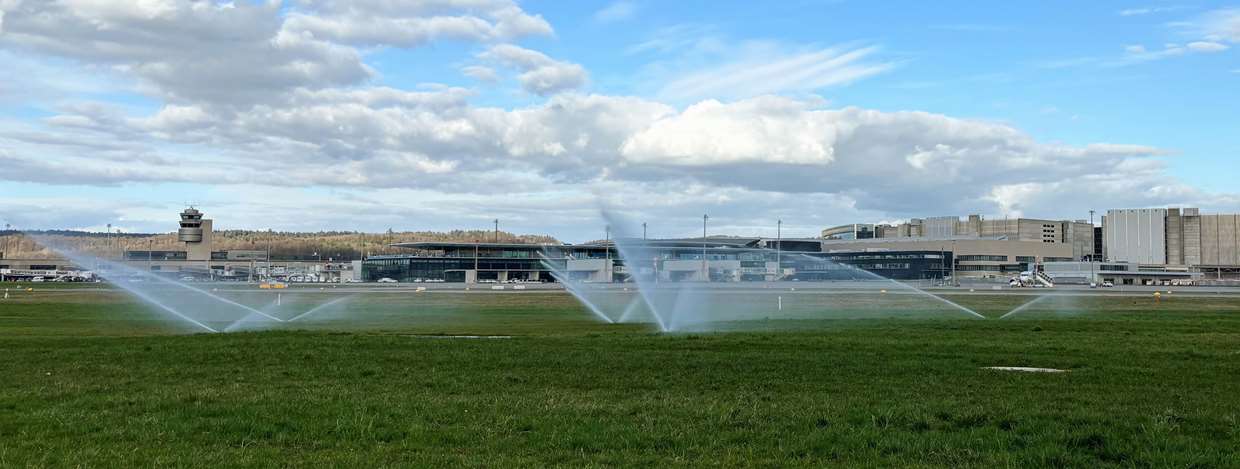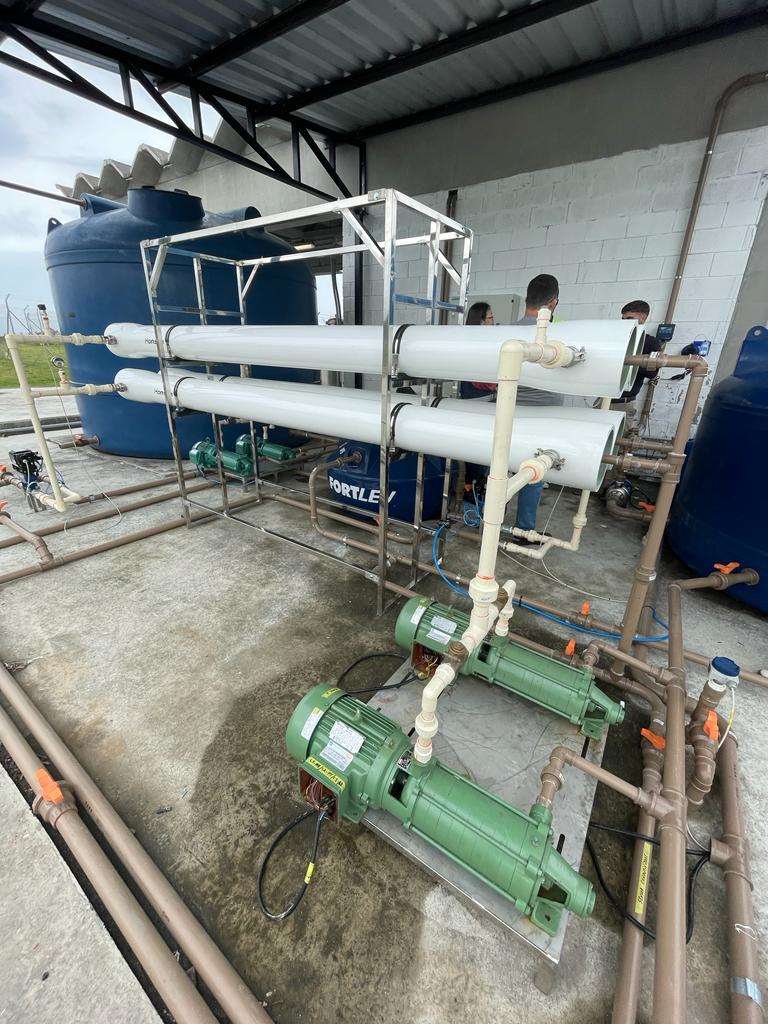Water
Clean drinking water cannot be taken for granted. The Zurich Airport Group therefore uses water resources sparingly.
Relevance
Clean water is a precious resource which Zurich Airport Ltd. is committed to conserving at all its airports. Along with minimising the volume of fresh water consumed, the company ensures wastewater is appropriately treated to keep watercourses clean. Various types of wastewater are produced at airports, each of which must be treated in different ways. These include domestic wastewater, aircraft sewage and wastewater from workshops, as well as runoff from operational areas and from aircraft de-icing.
Approach
Fresh water
Zurich Airport obtains drinking water from the municipal water supply for the town of Kloten. It also pumps groundwater itself. This is because some parts of the infrastructure are located below ground which are at risk if the groundwater table rises above a critical level. The pumped groundwater is used as process water and for toilet flushing. Rainwater collected from roofs is also used to flush some toilets, which additionally helps to control rainwater runoff.
The airports in Latin America likewise obtain their drinking water from the public water supply and are constantly taking steps to reduce their demand for fresh water. The three Brazilian airports in Florianópolis, Vitória and Macaé launched the “Aqua Project” which aims to reduce the demand for fresh water. This project has been the recipient of several sustainability awards. The project has three elements: treating used water, reducing demand, and accurately measuring consumption. This resulted in a 17% reduction in water demand in the reporting year, although not all plants were operating normally. In the year under review, the airports at Florianópolis and Vitória invested in expanding their systems for treating rainwater, for using treated water for cooling, and for using wastewater from fire engines in Vitória. At Florianópolis airport, a wastewater treatment plant that works on the reverse osmosis principle was set up. In addition, existing fixtures were replaced by water-saving ones and system maintenance was stepped up. Measuring and monitoring water usage on a daily basis enables speedy intervention if any changes in usage patterns are detected.
Noida Airport in India plans to meet 80% of its fresh water needs with treated rainwater. As Noida lies in a tropical zone with seasonal heavy precipitation, rainwater will be stored in tanks for use later in the year.
Wastewater
Like the municipalities in the canton, Zurich Airport has its own general drainage plan (GEP) which sets out the basic principles for water protection on the airfield. Following the “prevent – separate – treat” approach, the aim is to produce as little wastewater as possible. Along with measures to ensure airfield drainage systems meet the regulations, the drainage plan includes stipulations relating to the operation and maintenance of the existing sewage and pump systems.
In accordance with the drainage plan, the wastewater produced at Zurich Airport is separated and suitably treated. All domestic wastewater, from toilets or restaurant kitchens for example, is discharged into the local sewage treatment plant (STP) at Kloten-Opfikon where it is treated. The contents of grease separators are sent to a biogas plant. Special wastewater, from workshops or from aircraft toilets for example, requires pre-treatment before likewise being sent on to the sewage plant.
The airports in Latin America all have their own wastewater treatment plants from which the treated water is directly discharged into watercourses or, as in Florianópolis in Brazil and Antofagasta in Chile, is used locally for irrigation. A wastewater treatment plant is also planned for Noida in India in order to produce greywater that can be used for cooling and irrigation purposes, for instance.
Aircraft and surface de-icing
In order to ensure safe flight operations, in winter it is essential to keep both aircraft and operational areas at Zurich Airport free of ice. Average precipitation, but little snow was recorded over the winter of 2022/2023. Accordingly, the quantity of surface de-icing agents consumed was much lower than the long-term average. An average amount of aircraft de-icing agents was consumed. Propylene glycol is used for aircraft de-icing, whereas formate is used as a surface de-icing agent. Conventional de-icing salts are used on service roads, in the car parks and around the maintenance area.
Wastewater runoff from operational areas contaminated with de-icing agents is collected and is treated in one of three ways depending on the degree of contamination (more detailed information can be found online at Zurich Airport De-Icing Wastewater). One unique feature of treatment is the spraying of medium-contaminated wastewater over suitable green areas. As the water percolates down through the soil, the carbon compounds from the propylene glycol and the formate biodegrade, thus cleaning the wastewater in the process.

The sprinkler system sprays wastewater containing de-icing agents onto green spaces. The water is cleaned as it percolates down through the soil.
To assess the success of the cleaning systems, the degree of treatment is calculated for each winter season. This indicates what percentage of carbon contained in the collected wastewater was removed. In the winter of 2022/2023, the degree of treatment was 96%. The amount of carbon effectively untreated was 15 tonnes.
Key data
Fresh water consumption
|
GRI 303 – 3 |
|
|
|
|
|
|
|
|
|
|
|
|
|
|
|
|
|
|
|
|
|
|
|
|
|
|
|
Zurich Airport, Switzerland |
|
Unit |
|
2019 |
|
2020 |
|
2021 |
|
2022 |
|
2023 |
|
Drinking water |
|
m 3 |
|
649,997 |
|
410,550 |
|
402,903 |
|
499,552 |
|
579,792 |
|
Groundwater |
|
m 3 |
|
188,230 |
|
100,980 |
|
113,069 |
|
208,874 |
|
168,505 |
|
Rainwater |
|
m 3 |
|
13,180 |
|
3,712 |
|
4,993 |
|
9,490 |
|
14,283 |
|
Total fresh water |
|
m 3 |
|
851,407 |
|
515,242 |
|
520,965 |
|
717,916 |
|
762,580 |
|
|
|
|
|
|
|
|
|
|
|
|
|
|
|
Florianópolis Airport, Brazil |
|
Unit |
|
2019 |
|
2020 |
|
2021 |
|
2022 |
|
2023 |
|
Drinking water |
|
m 3 |
|
n/a |
|
n/a |
|
n/a |
|
n/a |
|
67,634 |
|
Recycled STP Water |
|
m 3 |
|
n/a |
|
n/a |
|
n/a |
|
n/a |
|
62 |
|
Rainwater |
|
m 3 |
|
n/a |
|
n/a |
|
n/a |
|
n/a |
|
8,551 |
|
Total fresh water |
|
m 3 |
|
n/a |
|
n/a |
|
n/a |
|
n/a |
|
76,247 |
|
|
|
|
|
|
|
|
|
|
|
|
|
|
|
Vitória/Macaé Airports, Brazil |
|
Unit |
|
2019 |
|
2020 |
|
2021 |
|
2022 |
|
2023 |
|
Drinking water |
|
m 3 |
|
n/a |
|
n/a |
|
n/a |
|
n/a |
|
83,940 |
|
Rainwater |
|
m 3 |
|
n/a |
|
n/a |
|
n/a |
|
n/a |
|
6,379 |
|
Total fresh water |
|
m 3 |
|
n/a |
|
n/a |
|
n/a |
|
n/a |
|
90,319 |
|
|
|
|
|
|
|
|
|
|
|
|
|
|
|
Natal Airport, Brazil |
|
Unit |
|
2019 |
|
2020 |
|
2021 |
|
2022 |
|
2023 |
|
Total fresh water |
|
m 3 |
|
n/a |
|
n/a |
|
n/a |
|
n/a |
|
n/a |
|
|
|
|
|
|
|
|
|
|
|
|
|
|
|
Antofagasta Airport, Chile |
|
Unit |
|
2019 |
|
2020 |
|
2021 |
|
2022 |
|
2023 |
|
Drinking water |
|
m 3 |
|
n/a |
|
n/a |
|
n/a |
|
n/a |
|
32,400 |
|
Recycled STP Water |
|
m 3 |
|
n/a |
|
n/a |
|
n/a |
|
n/a |
|
2,736 |
|
Total fresh water |
|
m 3 |
|
n/a |
|
n/a |
|
n/a |
|
n/a |
|
35,136 |
|
|
|
|
|
|
|
|
|
|
|
|
|
|
|
Iquique Airport, Chile |
|
Unit |
|
2019 |
|
2020 |
|
2021 |
|
2022 |
|
2023 |
|
Drinking water |
|
m 3 |
|
n/a |
|
n/a |
|
n/a |
|
n/a |
|
50,400 |
|
Total fresh water |
|
m 3 |
|
n/a |
|
n/a |
|
n/a |
|
n/a |
|
50,400 |
|
|
|
|
|
|
|
|
|
|
|
|
|
|
|
Noida Airport, India |
|
Unit |
|
2019 |
|
2020 |
|
2021 |
|
2022 |
|
2023 |
|
Total fresh water |
|
m 3 |
|
n/a |
|
n/a |
|
n/a |
|
n/a |
|
n/a |
Consumption of de-icing agents
|
AO6 |
|
|
|
|
|
|
|
|
|
|
|
|
|
|
|
|
|
|
|
|
|
|
|
|
|
|
|
Zurich Airport, Switzerland |
|
Unit |
|
2018/19 |
|
2019/20 |
|
2020/21 |
|
2021/22 |
|
2022/23 |
|
Aircraft de-icer |
|
m 3 |
|
2,113 |
|
982 |
|
862 |
|
1,252 |
|
1,474 |
|
Surface de-icing agents formate solution |
|
m 3 |
|
1,364 |
|
112 |
|
1,338 |
|
501 |
|
515 |
|
Surface de-icing agents solid |
|
Tonnes |
|
0 |
|
0 |
|
16 |
|
0 |
|
4 |
|
De-icing salts for other surfaces |
|
Tonnes |
|
349 |
|
60 |
|
569 |
|
137 |
|
204 |
|
Degree of treatment (aprons, runway and taxiways) |
|
in % |
|
94 |
|
98 |
|
88 |
|
95 |
|
96 |
|
Washed off untreated carbon |
|
Tonnes |
|
30 |
|
5 |
|
23 |
|
13 |
|
15 |


